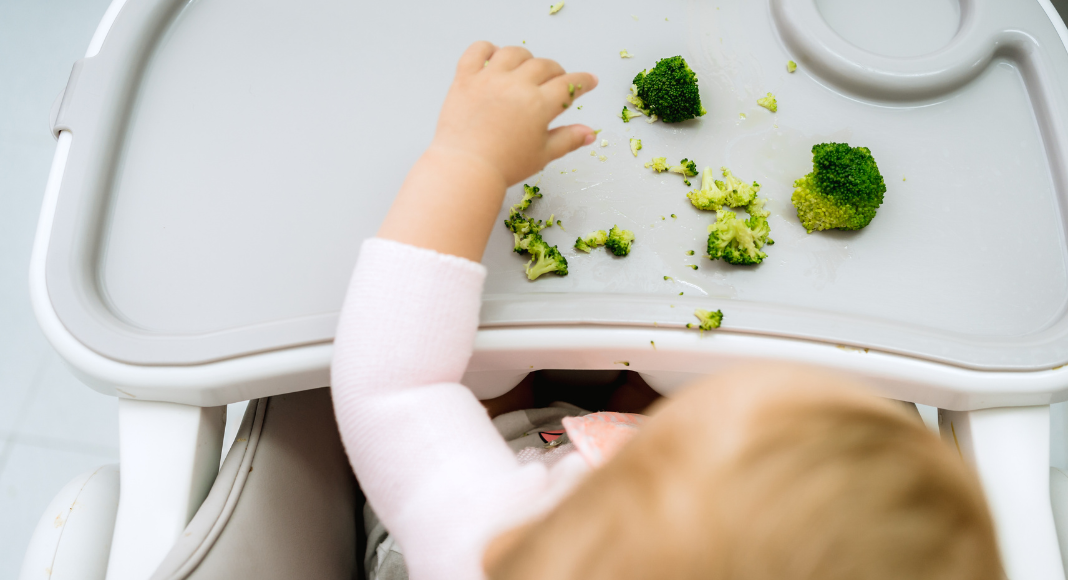 Baby-Led Weaning (or BLW) is something we loved and had great success with. It makes life a lot easier because you’re not making different meals for your baby; they can eat whatever the family is eating or even eat with you when you go out to restaurants. It takes some work in the beginning and is EXTREMELY messy, but it is worth it in the long run!
Baby-Led Weaning (or BLW) is something we loved and had great success with. It makes life a lot easier because you’re not making different meals for your baby; they can eat whatever the family is eating or even eat with you when you go out to restaurants. It takes some work in the beginning and is EXTREMELY messy, but it is worth it in the long run!
1. Find a food baby loves and use that food to introduce something new.
For example, if your baby loves broccoli, keep that on the plate at mealtimes, but add something they haven’t seen before so that they feel comfortable and recognize something on the plate. They might not go for the new food initially, but the exposure over time is important.
2. Try spreading new foods on toast.
For example, nut butter, mashed boiled egg, kidney beans, or black beans. This is also a perfect way to introduce allergens (eggs and nuts), and you can mash beans on toast and any other food to try so that baby has an easy way to hold the foods.
3. Keep meats in sauce or broth and serve them moist.
Serving meats in their juices and cooking in sauces or broths keeps the meat moist. Keep it on the spoon and plate with this juice to make it easier for them to swallow and less of a choking hazard.
4. Make sure you are reading your baby’s cues.
It’s okay to spoon-feed if your baby has clear cues for when they want more or are done. Many think baby-led weaning means no spoon-feeding, but this isn’t true. Please make sure you are aware of feeding cues and try to slow down and encourage them to feel the food and hold the spoon themselves.
5. Don’t assume your little one doesn’t like something after not wanting it the first time.
Keep introducing it and even if it’s on the plate and they don’t want it, keep exposing them to that food. One day, maybe even after weeks of not wanting to touch that food, they might surprise you and try a little.
6. Puffs get a bad rap, but they are small foods and easy to store when you’re out.
They helped our little guy get used to smaller bits of food once he was about eight months old. They aren’t always great for nutritional purposes, so it’s not something to do all the time. I use them more like a treat, but they immensely helped my son’s pincer grasp.
7. Make soup and keep it frozen in large ice cube trays.
This is great when you don’t want to cook but need something nutritious. This can work for the entire family and works great with some toast they can dip in the soup.
8. Don’t be afraid to use butter or olive oil for cooking.
We are often reserved with these foods when cooking for ourselves, but little ones need the essential fats for brain development.
9. Instead of buying ‘baby yogurt,’ use whole milk plain yogurt.
A lot of the kids’ brands are expensive and have added sugar. Plus, your little one can get used to the branded character yogurt and only want that. Instead, I buy whole fat (again, the fat for babies is important), smash some blueberries, or blend some frozen fruit and mix it into the yogurt to sweeten.
10. Educate yourself on choking hazards and common allergens.
You’ll feel more confident knowing what to do in that situation. But remember, the baby’s gag reflex kicks in, which is different from choking! For some foods, we would modify them to ensure they weren’t a choking hazard. For example, squash blueberries and mash kidney beans a little, so it’s still chunky but not whole.




















